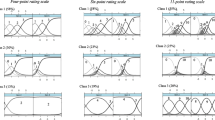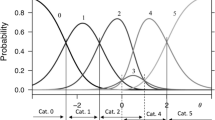Abstract
In this research the impact of two types of end anchors on the linearity of the category rating scale is studied. Two functional measurement experiments were carried out, each requiring a different kind of judgement, i.e., job satisfaction ratings and attractiveness ratings. One group of participants rated the stimuli using a category rating scale with fixed anchors, while another group was presented with a self-anchoring category rating scale. The results indicate that researchers can be confident in the ability of both category rating scales to provide linear data. This implies that the different end anchors do not impact on the linearity of the category rating scale.
Similar content being viewed by others
References
Anderson N.H.: Averaging versus adding as a stimulus-combination rule in impression formation. J. Exp. Psychol. 70, 394–400 (1965)
Anderson N.H.: Note on functional measurement and data analysis. Percept. Psychophys. 21, 201–215 (1977)
Anderson N.H.: Foundations of information integration theory. Academic Press, London (1981)
Anderson N.H.: Methods of information integration theory. Academic Press, London (1982)
Anderson N.H.: Integration psychophysics and cognition. In: Algom, D. (eds) Psychophysical Approaches to Cognition, pp. 13–113. Elsevier Science Publishers, North-Holland (1992)
Anderson N.H.: A Functional Theory of Cognition. Lawrence Erlbaum Associates, New Jersey (1996)
Anderson, N.H.: Unified social cognition. Academic press, London (2008)
Baguley T.: Understanding statistical power in the context of applied research. Appl. Ergon. 35, 73–80 (2004)
Bartoshuk L.M.: Comparing sensory experiences across individuals: recent psychophysical advances illuminate genetic variation in taste perception. Chem. Senses 25, 447–460 (2000)
Birnbaum M.H., Veit C.T.: Scale convergence as a criterion for rescaling: information integration with difference, ratio, and averaging tasks. Percept. Psychophys. 15, 7–15 (1974)
Blanton H., Jaccard J.: Arbitrary metrics in psychology. Am. Psychol. 61, 27–41 (2006)
Braun, C., Gruendl, M., Marberger, C., and Scherber, C. In: Beautycheck - Ursachen und Folgen von Attraktivitaet. http://www.beautycheck.de/english/bericht/bericht.htm. Cited 18 April 2006 (2001)
Breakwell G.M., Hammond S., Fife-Shaw C.: Research Methods in Psychology. Sage Publications, London (2000)
Cantril H.: The Pattern of Human Concerns. Rutgers University Press, New Jersey (1965)
Friedman H.H., Amoo T.: Rating the rating scales. J. Mark. Manag. 9, 114–123 (1999)
Dalal A.K., Singh R.: An integration theoretical analysis of expected job attractiveness and satisfaction. Int. J. Psychol. 21, 555–564 (1986)
Hoenig J.M., Heisey D.M.: The abuse of power; the pervasive fallacy of power calculations for data analysis. Am. Stat. 55, 1–6 (2001)
Hofmans, J., Mairesse, O., Theuns, P.: An alternative for prescribed integration rules in testing the linearity of a response measure. Teor. Model. 12, 259–268 (2007a)
Hofmans J., Theuns P., Baekelandt S., Schillewaert N., Cools W. Bias and changes in perceived intensity of verbal qualifiers effected by scale orientation. Surv. Res. Methods 1,4 97–108 (2007b)
Kilpatrick F.P., Cantril H.: Self-anchoring scale: a measure of the individual’s unique reality world. J. Individ. Psychol. 16, 158–170 (1960)
Lefcowitz M.J., Wallston B.: Self-anchoring scale: does it make a difference? Sociol. Methods Res. 1, 387–399 (1973)
Norman K.L.: A solution for weights and scale values in functional measurement. Psychol. Rev. 83, 80–84 (1976)
Parducci A.: Range-frequency compromise in judgment. Psychol. Monogr. Gen. Appl. 77, 1–50 (1963)
Poulton E.C.: Bias in Quantifying Judgments. Lawrence Erlbaum Associates Publishers, Hove and London (1989)
Robinson M.E., Gagnon C.M., Dannecker E.A., Brown J.L., Jump R.L., Price D.D.: Sex differences in common pain events: expectations and anchors. J. Pain 4, 40–45 (2003)
Stevens S.S.: Issues in psychophysical measurement. Psychol. Rev. 78, 426–450 (1971)
Stevens S.S., Galanter E.H.: Ratio scales and category scales for a dozen perceptual continua. J. Exp. Psychol. 54, 377–411 (1957)
Veit C.T.: Ratio and subtractive processes in psychophysical judgment. J. Exp. Psychol. Gen. 107, 81–107 (1978)
Weiss D.J.: Averaging: an empirical validity criterion for magnitude estimation. Percept. Psychophys. 12, 385–388 (1972)
Weiss D.J.: Analysis of Variance and Functional Measurement: A Practical Guide. Oxford University Press, New York (2006)
Whitley B.E. Jr: Principles of Research in Behavioral Science. McGraww-Hill, New York (2002)
Zhu S., Anderson N.H.: Self-estimation of weight parameter in multiattribute analysis. Organ. Behav. Hum. Decis. Process 48, 36–54 (1991)
Author information
Authors and Affiliations
Corresponding author
Rights and permissions
About this article
Cite this article
Hofmans, J., Theuns, P. Testing the impact of predefined and self-defined end anchors on the linearity of the category rating scale. Qual Quant 44, 397–408 (2010). https://doi.org/10.1007/s11135-008-9209-4
Published:
Issue Date:
DOI: https://doi.org/10.1007/s11135-008-9209-4




